Media | Articles
1955 Cadillac Coupe de Ville: Gold Goddess

Sixty-eight years ago, Americans were spoiled for choice and style in their cars. Unlike today, where seemingly three-quarters of the population want something staid and “comboverish,” you could get all manner of snazzy cars in snazzy colors, ample body styles, and myriad options, wheel treatments, and fabrics. And in 1955, Cadillac was king of the hill.
For instance, at least in my opinion, it seems that three-quarters of new cars are of the style deemed “willfully ugly.” I remember Bill Mitchell saying decades ago that it costs as much to design and build an ugly car as it does a beautiful one. So where have all the beautiful cars gone? Well, last June many of them were in Lombard, Illinois, at the CLC Grand National meet.
In 1955, you could get any kind of Cadillac you wanted, as long as it was a car. Yes, a CAR. No sport utilities, no 4x4s, no crossovers. You could get anything from a Series 62 pillared sedan to an Eldorado Biarritz convertible, or factory-built Series 75 Fleetwood limo, complete with power divider window separating the chauffeur from the captain of industry in the back seat.
The snazziest Cadillac that year was arguably the Coupe de Ville. The model initially was introduced in 1949, an all-new body style dubbed the “hardtop convertible,” as the roof resembled a convertible with its top up when all the side windows were lowered. The most prominent feature was no B-pillar, to further the convertible look. But by 1955, the Series 62 two-door had adopted the same roofline, so the biggest differences between it and the Coupe de Ville was a plusher, brighter interior and gold-toned “Coupe de Ville” scripts below the rear quarter windows.
A total of 140,777 Cadillacs were built for the 1955 model year, which set a record at the time for the luxury make. The Coupe de Ville itself sold for $4305 (about $49,000 today) before options. Curb weight was 4424 pounds and 33,300 were sold.
Marketplace
Buy and sell classics with confidence
The Series 62 coupe had most of the Coupe de Ville’s style but was a little less dear at $3882 ($44,195). Most expensive? The Series 75 Fleetwood Imperial sedan—Cadillac’s term for the formal limousine—at $6402 ($72,885). By the way, if you ever see a ’55 Series 75 Imperial limo, you should take plenty of pictures. Only 841 were built.
The new Cadillacs had only minor detail changes for 1955, as they had been totally restyled for the ’54 model year. All ’55s had the 331-cubic-inch V-8 under the hood. Bore and stroke were 3.81 x 3.63. Horsepower was 250 at 4600 rpm. Eldorados had 270 hp, thanks to twin four-barrel carbs.
However, any new Cadillac could get the 270-hp engine by checking the “Power Package” option for $160 ($1822) extra. Factory air conditioning was also available, for a princely $620 ($7058).
The most noticeable differences to the exterior of 1955 Cadillacs, compared to the outgoing ’54s, were a new grille with prominent “Dagmar” bumper bullets and a revised chrome side-molding that started at the front fender and moved down the flank in a continuous line until abruptly turning up just behind the front door on two-door models.
The ’54s had the same molding begin at the front, but it went straight back before ending before a heavy simulated chrome air duct at the front of the rear quarter panel. The ’55s took those two trim pieces and rather smoothly combined them into one trim piece. As I recall from one of my Cadillac books, GM designer Dave Holls created that for the ’55s.
Since there were only minor refinements for the year, Cadillac talked up its engine in the showroom brochures. It was the same basic 331-cu-in block, but back then it was constantly being refined. While the ’54 engine was 230 hp @ 4400 rpm, the ’55 version (as previously mentioned) was 250 @ 4600. And that was sans the 270-hp dual four-barrel carb option.
As the brochure relayed, “For 1955, Cadillac presents the most perfectly proportioned automotive power plant [that] science, skill, and experience can produce … with its new and far higher compression ratio of 9.0 to 1, it provides a tremendous reserve in performance, infinite flexibility under all driving conditions, and even more surprising economy of operation.”
But, of course, luxury was just as important as—if not more than—performance. The selling point of the pricier Coupe de Ville over the Series 62 hardtop was the interior. Again from the brochure: “Interiors are blue, tan, or green—tailored in patterned and metallic nylon and dark leathers.
“Also offered are three exciting and unusual new ‘glamour’ interiors, featuring a special V-pattern metallic nylon in black, green, or gold—set off by copper-tone, green, and white leather, respectively.” That latter gold-and-white interior is what our featured Coupe de Ville sports. And appropriately, this car is painted in Goddess Gold, though at first I thought it could also be Cape Ivory.
Cadillac buyers were spoiled for color choices in 1955, that’s for sure. Among the tempting hues were Mist Green, Azure Blue, Pacific Coral, Mandan Red, Bahama Blue, and Deep Cherry. With many contrasting or complementary interior choices available as well.
This was the next-to-last car I photographed at the CLC Lombard show. It was a fantastic day, and after dinner at Harry Caray’s inside the Westin, my friend Jayson and I moseyed among the parked show entries as we made our way back to my car for the trip home. I really loved this car, especially the colors. Cadillac could do no wrong in the 1950s, that’s for sure.
Once upon a time, America made cars like this. I missed it by 25 years, but I still feel a loss when I see a wonderful car like this. I think the 1955 me, if I existed then, would have loved listening to Fats Domino on the AM while driving a lovely cruiser like this.
***
Check out the Hagerty Media homepage so you don’t miss a single story, or better yet, bookmark it. To get our best stories delivered right to your inbox, subscribe to our newsletters.

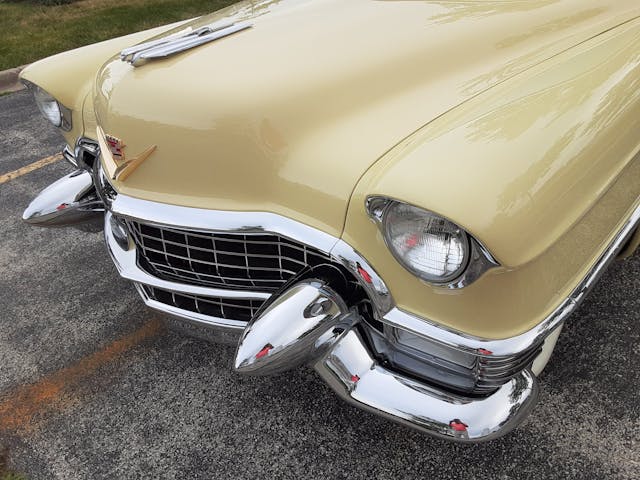
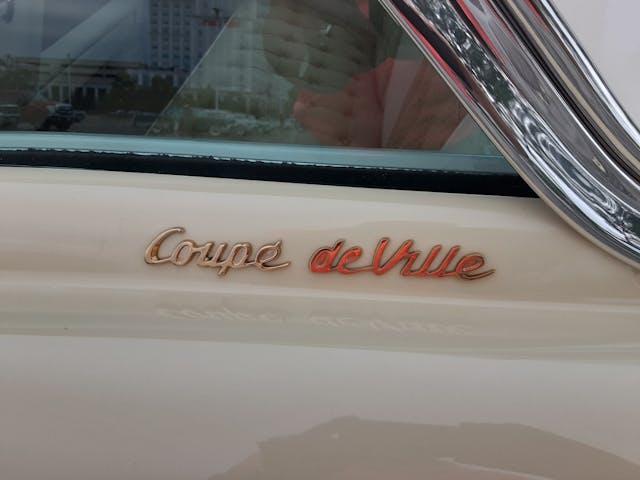

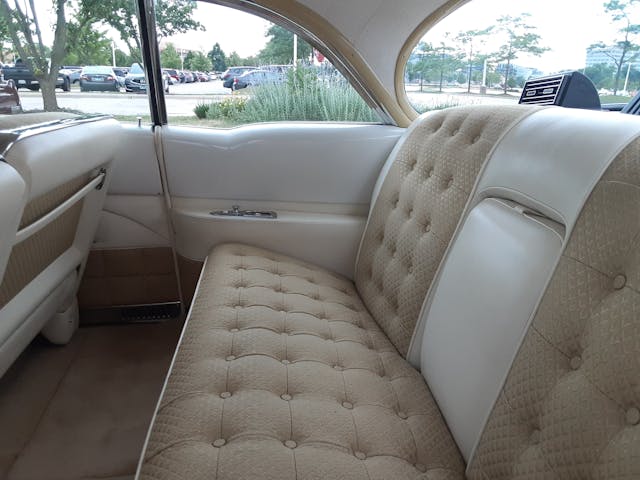
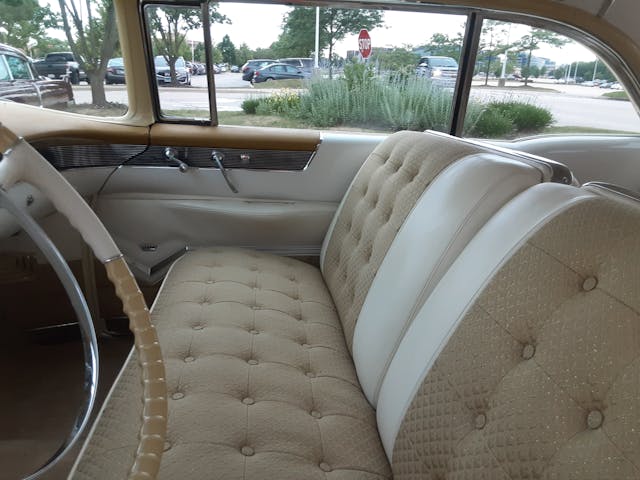







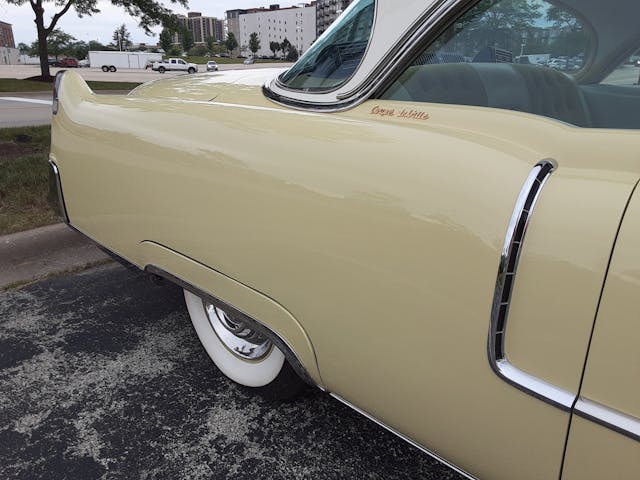
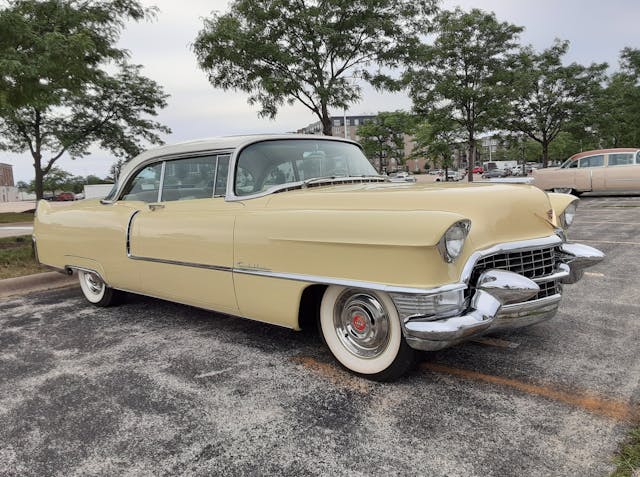




















Beautiful car! Cadillac and GM were on top…those were the days…
Amen, those were the days. I was only a year old when this car was built, but I remember them. What I wouldn’t give to return to those times now…
Pretty car – not the color I would have chosen, but pretty nonetheless.
Yep, this one’s a real beauty — mint!
Now, about “only cars”… You could buy a station wagon or pickup from them, but they were named hearse and flower car.
Those were not “factory” vehicles..
I remember one just like the featured car. It belonged to a classmate’s father. At the time the car was around 15 years old and much the worse for wear. Still, I could picture it in it’s former glory and never skipped an opportunity to gawk at it.
You missed “Arlington” Green, the first production metallic paint ever offered.
I could never fit this in my garage, beautiful car and great color.
As amazed as some younger folks might be to hear there was no Caddy SUV back then, (What?) I can only imagine how cool, (or how ugly) a 1955 GMC Suburban with DeVille styling cues would be. Sorry for that visual… I’ll shut up now.
I remember my parents shopping for a used first car for my mom in 1968. They were tempted by the twin of this car, in similar condition, for $300. Unfortunately, we ended up with a more practical 1960 Rambler for the same price. My mom has never forgotten about this missed opportunity.
A beautiful time capsule to be sure!!! But the thing in the article that most stood out for me was that the top whack Cadi, excluding the limo, was just around $53,000 in today’s money. WOW! Today that will get you a top of the line Kia. Why are cars so much more expensive now? Safety, etc. sure. But come on. Pretty much double the money?
A beautiful car. A long time ago I worked in Lombard, Il.
I just saw the identical car last Sunday in Stoney Creek, Ontario, Canada.
Took me awhile to take my eyes off of it.
My parents owned one exactly like it! It didn’t have air conditioning but was a great road car. My Dad had to work in Phoenix, Arizona for a few months working for Douglass Aircraft at the time. Arizona had no speed limits in 1957 or if they did, didn’t enforce them on the highway, so my Dad would do 90-100 mph after leaving work and drive to our house in Los Angeles. He did this about every other weekend or at least once a month. He and my Mom would drive it to San Francisco to visit friends and make the 400 miles on a single tank of gas. Not sure how fast he drove at that time, but most freeway speed limits were 65 mph and the Highway Patrol was not very forgiving if you went more than 5 mph over any speed limits back then. They had to sell that car after my Dad was laid off from Douglass in 1958 and they bought a service laundry and needed a station wagon to deliver laundry to homes. Broke my Mother’s heart when they sold it!
These and most cars back then were all steel with no plastic components in them. The 54 Olds Super 88 convertible I sold a couple years ago had terminal lugs with screws on the ignition switch. I was amazed when I had to change the switch. This is such a beautiful car.
In 1957 my Dad bought a ’55 Fleetwood sedan–completely loaded–automatic headlight dimmer, Wonderbar radio and factory air. It was Pacific Coral (kinda like Univ of Tennessee orange) with a white top. The only Fleetwood sedan I’ve ever seen painted that color–usually found on Coupe de Villes and convertibles. But instead of the matching coral leather/white fabric interior (the featured color that year), it had very somber brownish/tan cloth seats. My Mom tolerated that orange exterior for about six months, and had Dad repaint the orange light blue. I learned to drive in that car, and practiced parallel parking with it, so that when I took my driver’s test–in a Chevy–I breezed right into the test parking space.
Many years later a friend bought a ’55 Fleetwood–with even more options than Dad’s–that was a factory W-code special order: all white exterior (all Fleetwoods that year were two toned), an Eldorado engine (2 x 4 barrels) and the Pacific coral leather/white brocade interior that should have been in Dad’s car. We often speculated on who had originally ordered that car…
I was born in Detroit in 1955. I knew soon after that I would be a Gearhead all my life, and I am. In 1963, my dad bought a 56 Coupe deville. It was lilac with a white roof and white and lilac interior. Nobody’s favorite. I was bought new in Chicago, and it belonged to the sister of our neighbors who lived across the street. It didn’t take long to realize it was a Chicago rust bucket. There was plenty of rust along the sides. But it didn’t stop there. The floorboards had rusted thin above where the mufflers were mounted in the exhaust system. That was something we Californians never even thought about. As soon as it was running about 20 minutes, the entire back seat would heat up to a point that it was impossible to sit back there. Aside from the hideous color combo and rust, it wins first prize as the worst car my dad ever had. There were still plenty of them in SoCal, so the mid-50s cars were very popular, except rusted out cars from the east. In January 1964 dad traded it in for a cute little 64 Valient station wagon. It was white with red tuck and roll seats and red interior. It was equipped with Chrysler’s famous 225 Slant 6 engine and one barrel carburetor. It was slow by any means. Not suitable for vacations in the High Sierras. But it was perfect for mom’s car to drive around town. We replaced it with a 1963 Chrysler Newport 4 door hardtop, white with blue vinyl interior. It was the first car in the family to have factory installed air conditioning. Every car we owned since then has had A/C. I love American cars from the 50s, 60s and even the 70s. Now that all of today’s dull and boring, including the gray and shades of grays that dominate cars now have really made me appreciate our beautiful although at times over the top styling, I take them anytime over today’s cars that can only offer good mpg. So sad .